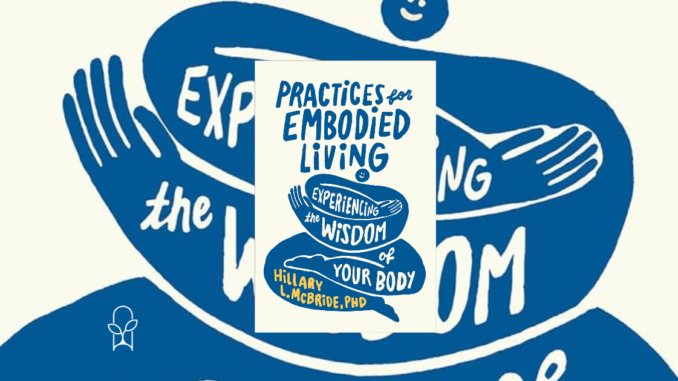
Also by this author: The Wisdom of Your Body: Finding Healing, Wholeness, and Connection Through Embodied Living
Published by Baker Publishing Group, Brazos Press on January 16, 2024
Genres: Non-Fiction, Social Justice
Buy on Amazon
Goodreads

In The Wisdom of Your Body, clinical psychologist and award-winning researcher Hillary McBride explored the ways many of us inherit a broken understanding of the body and offered a more compassionate, healthy, and holistic perspective on embodied life. In this follow-up book, McBride takes the principles of The Wisdom of Your Body and puts them into action in practical, tangible ways.
Practices for Embodied Living offers an experiential guide--centered on prompts, activities, and opportunities for reflection--to support readers who want to practice embodiment. This approachable, visually stimulating book helps individuals and groups resist cultural myths about ideal bodies, get in touch with the goodness of their bodies, and more fully inhabit themselves.
Topics include disembodiment, stress and trauma, sexuality, body image, pain and illness, oppression, and more. Each topic includes various exercises to help readers restore the mind-body connection.
This workbook connects with The Wisdom of Your Body by the same author. As Hillary McBride explains in the introduction, although she designed this as a practical supplement to her previous book, it also works as a standalone, especially for people who found her other book too academic and dense to process. She shares much of the same core information in simpler, more basic terms here, and this workbook covers all of the same themes. McBride wants to help people love and experience their bodies, instead of experiencing body shame or feeling disconnected from their physical selves, and she shares insights and teaching content throughout the book, explaining some of the issues that prevent people from engaging more fully with their bodies.
Each chapter involves multiple reflection questions and physical practices that people can explore. The practices are many and varied, with some things that sound more woo-woo, and others that are very straightforward and less weird. People who would anticipate balking at some of the activity ideas can still give this a chance, since there’s a wide range of things to chose from that will be more suited to their personality and self-expression. Overall, there’s a lot of helpful ideas here for how people can reconnect with their physical selves if they feel disengaged.
Although the information throughout this book is good, I don’t like the illustration style. I find the giant, disproportionate bodies and tiny heads unnerving, and I feel like the illustrations miss the point. Sure, we need to connect with our bodies and not think that we’re just minds walking around, but dramatically minimizing the head doesn’t seem wise or healing to me. Also, I didn’t care for the wild changes in font size in parts of the book. I found that distracting, but since I read a digital advance review copy, this might change before the book goes to print.
I also have some philosophical disagreements with the author, such as her insistence that there is never anything wrong with your body, just with a society that shames it or doesn’t accommodate it. That’s valid at some levels, but my body does have problems, and they’re not all society’s fault! I can love myself, love my body, and care for my body in the midst of my chronic pain and other health struggles while also accepting that my body has problems that other bodies don’t.
For sure, it’s a complicated issue, and I hold the good old FDA accountable for having approved all kinds of neurotoxins in food that made my life a torment for years until my family figured out what was wrong. Society has a role in my health problems, even when other people are unaffected. Still, I wish that the author made space for acknowledging individual frailties and physical problems, instead of putting the blame on society for any pain or issue you experience. This is also important for people who are experiencing pain due to reckless and dysfunctional choices they’ve made in the past. Inviting them to blame society does not bring emotional healing.
Also, even though one of the chapters addresses the spirit and body divide, the author wrote this in a very mainstream, secular way. It’s like any random book I might pick up at the library, and that’s not what I expected while reviewing a book from a Christian publisher. The author invites people to engage with whatever sense of divinity they experience outside of or within them, and although I’m sure she wants to help as many people as possible by making her work accessible to a pluralistic society, I found the lack of distinct Christian content disappointing.
Practices for Embodied Living: Experiencing the Wisdom of Your Body shares teaching and insight from the author, and gives a range of different reflection prompt and activity ideas for people to explore at their comfort level. This book will appeal to people who are trying to reconnect with their physical selves after trauma or just the everyday disconnect of Western society, and the author covers a variety of different topics and issues that many people will find helpful. I enjoyed aspects of this, but some of the author’s value judgments and preachy statements about society clashed with my different beliefs and perspectives. Also, Christian audiences need to know that this book does not provide a Christian viewpoint on embodiment, and is written in vague spiritual language for people of any belief or any practice.
